Are you a birdwatcher in New Mexico? If you are, you will already be well aware of just how many birds you can see in your state. But you may have overlooked some interesting species of blackbirds in New Mexico.
There are many members of the Icteridae family, or new world blackbirds to be seen in your state, along with one introduced European species.
Here is some information to help you identify different blackbirds you encounter, and learn when you might see them where you live.
Red-Winged Blackbird
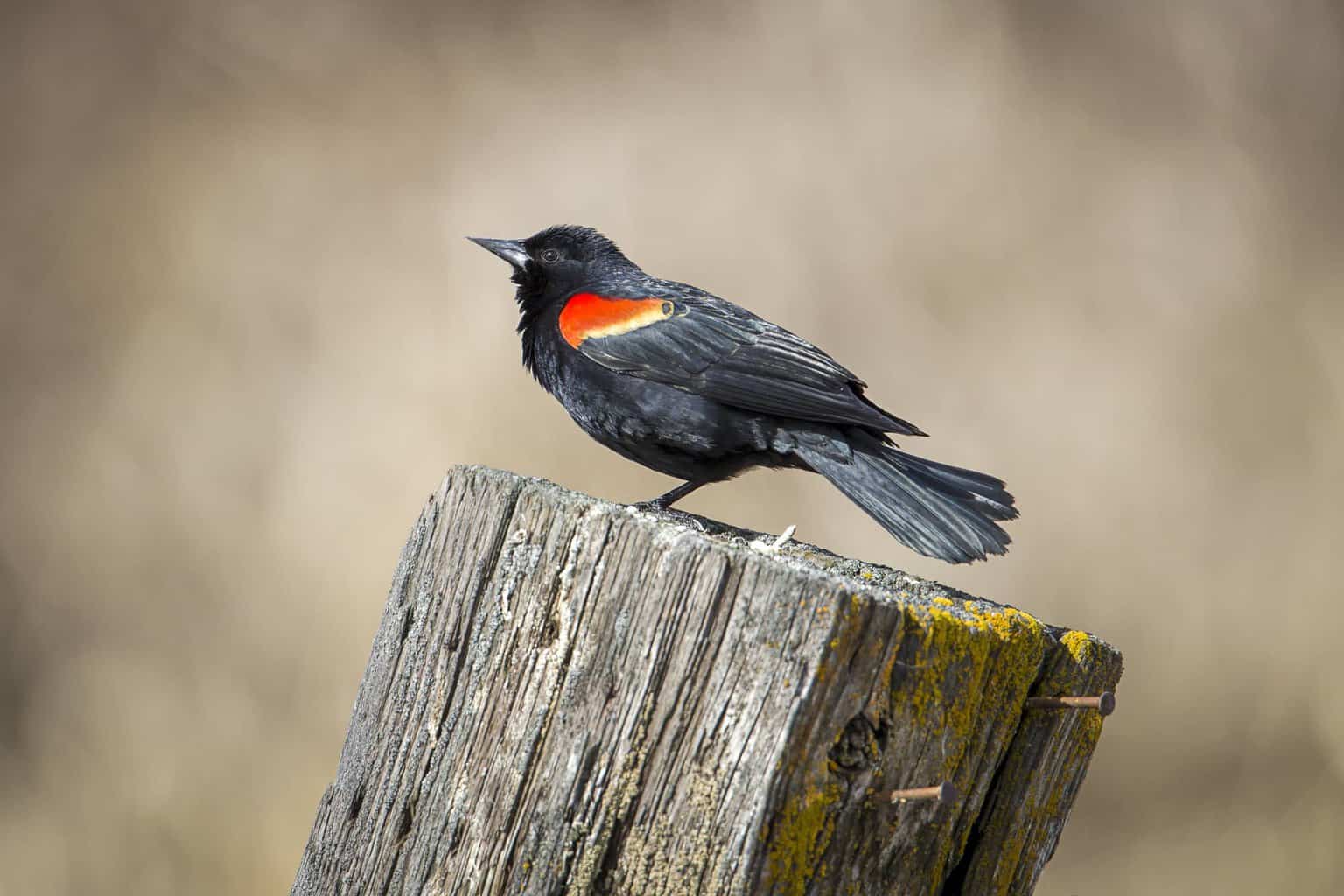
- Scientific Name: Agelaius phoeniceus
- Length: 6.7 – 9.1 in (17 – 23 cm)
- Weight: 1.1 – 2.7 oz (32 – 77 g)
- Wingspan: 12.2 – 15.8 in (31 – 40 cm)
The species of blackbird that you are most likely to see in New Mexico is the Red-Winged Blackbird. This species is the most commonly spotted blackbird in the state in summer, and the second most commonly seen in the winter months.
The male Red-Winged Blackbird is most easily identified. They are dark all over and have black wings except for bright flashes of red-orange on their wings.
The female birds are a dull, streaky brown. These birds may be seen eating insects in summer, but mostly turn their attention to seeds in the winter.
European Starling
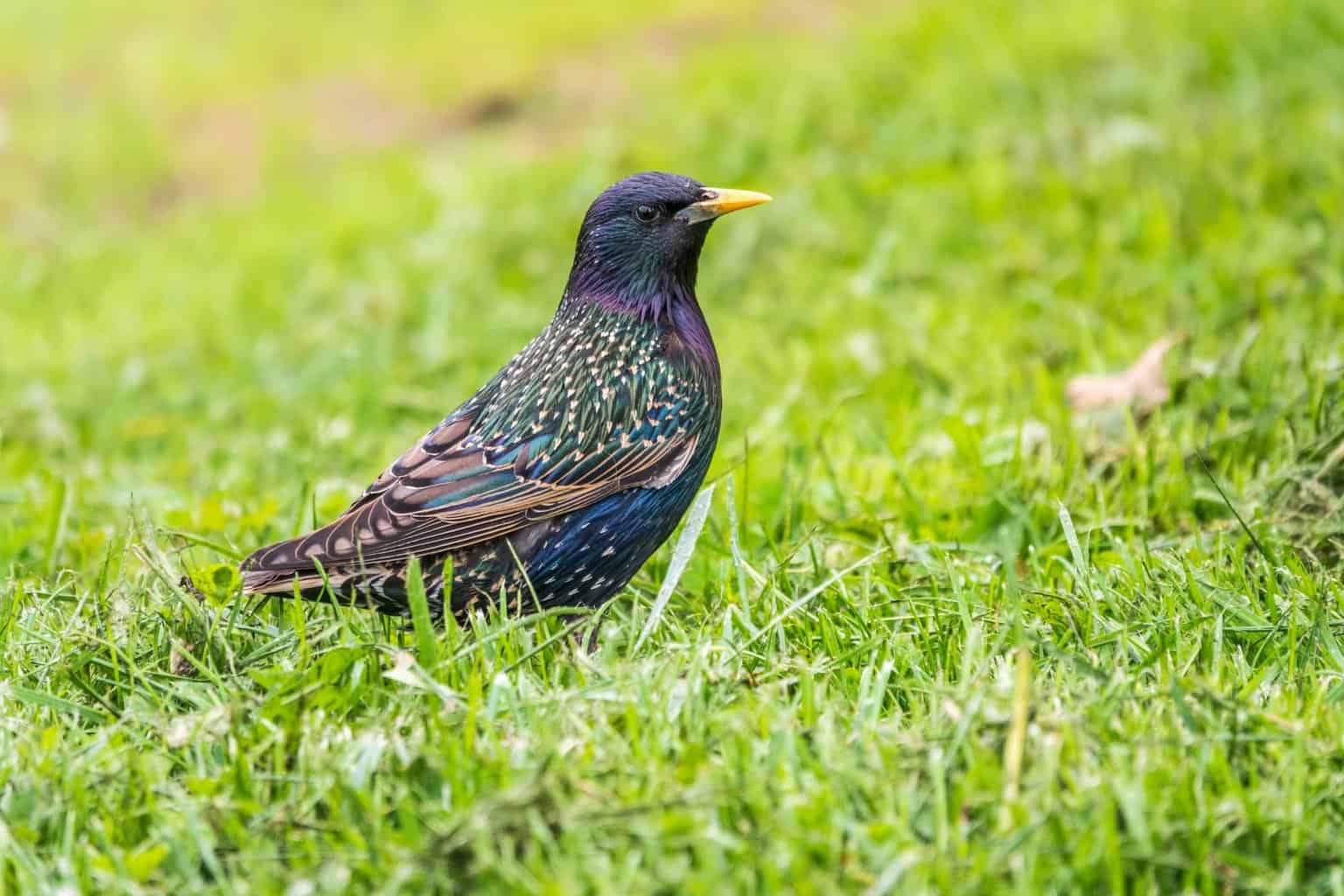
- Scientific Name: Sturnus vulgaris
- Length: 7.9 – 9.1 in (20 – 23 cm)
- Weight: 2.1 – 3.4 oz (60 – 96 g)
- Wingspan: 12.2 – 15.8 in (31 – 40 cm)
The European Starling is the only non-native species on this list. But this introduced species is now another of the most frequently spotted songbirds in the US. These birds can be seen in New Mexico year-round.
European Starlings look astonishing when swooping in massive flocks, and when viewed up close, have beautiful colors, with blue, purple, and green iridescence in their feathers.
Great-Tailed Grackle

- Scientific Name: Quiscalus mexicanus
- Length: 15.0 – 18.1 in (38 – 46 cm)
- Weight: 3.7 – 6.7 oz (105 – 190 g)
- Wingspan: 18.9 – 22.8 in (48 – 58 cm)
Great-Tailed Grackles are also spotted in New Mexico year-round. They are seen in massive flocks slightly more frequently in the summer but are also seen by many local birdwatchers in the winter months.
These slender blackbirds have long and impressive, tapered tails and long legs.
The males are glossy black with black wings and piercing yellow eyes, and the female birds are brown, darker on top, and lighter underneath, with thinner tails. The males are up to 60% heavier than the females.
Western Meadowlark
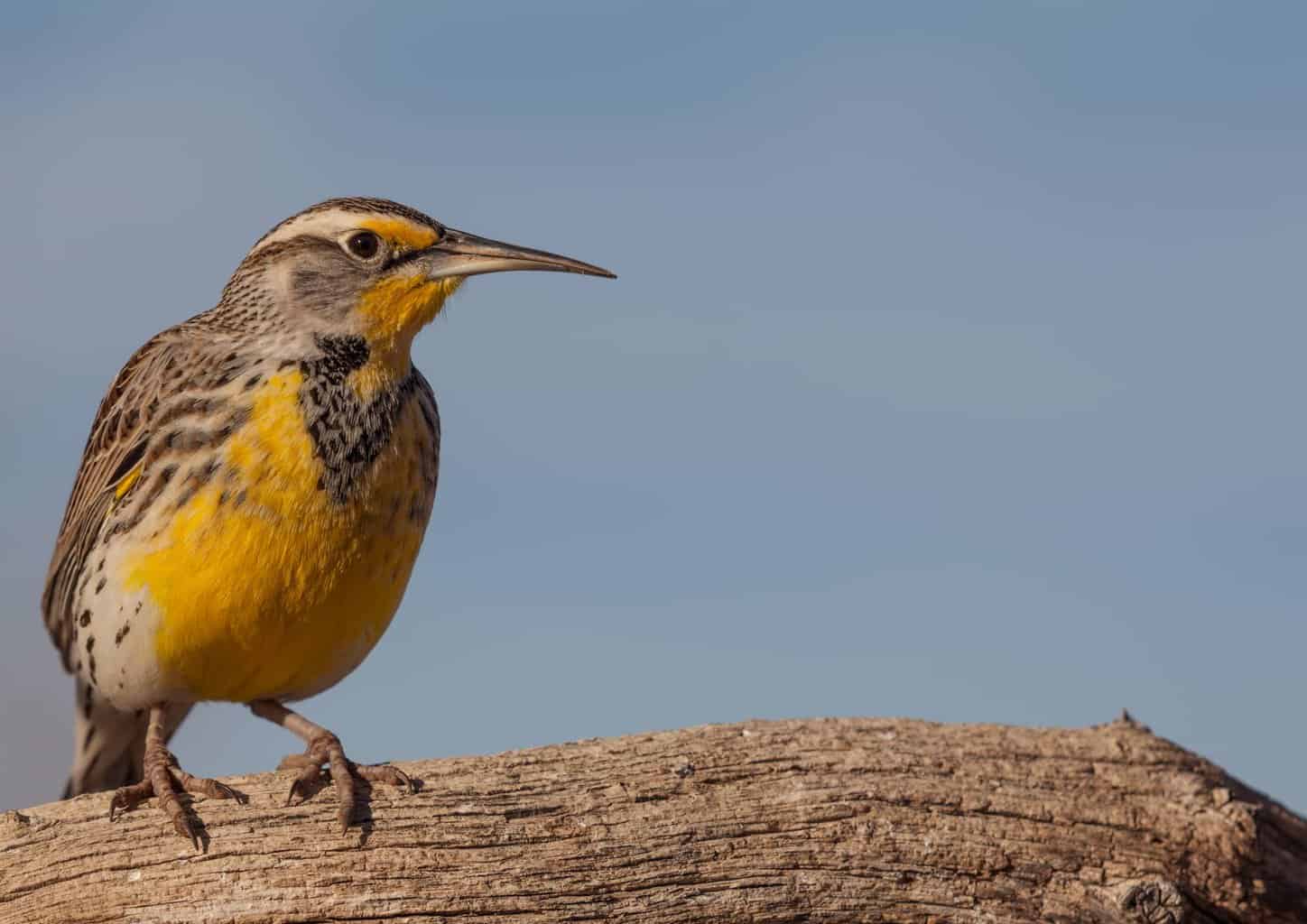
- Scientific Name: Sturnella neglecta
- Length: 6.3 – 10.2 in (16 – 26 cm)
- Weight: 3.1 – 4.1 oz (89 – 115 g)
- Wingspan: 16.1 in (41 cm)
The Western Meadowlark is also a resident in New Mexico throughout the whole of the year. Though again, they are spotted slightly more often in the summer.
Well known for their musical songs, Western Meadowlarks are around robin-sized. They have chests with yellow patches that have a black V shape across them, which turn gray in winter. Their upper parts are brown and white.
Brown-Headed Cowbird
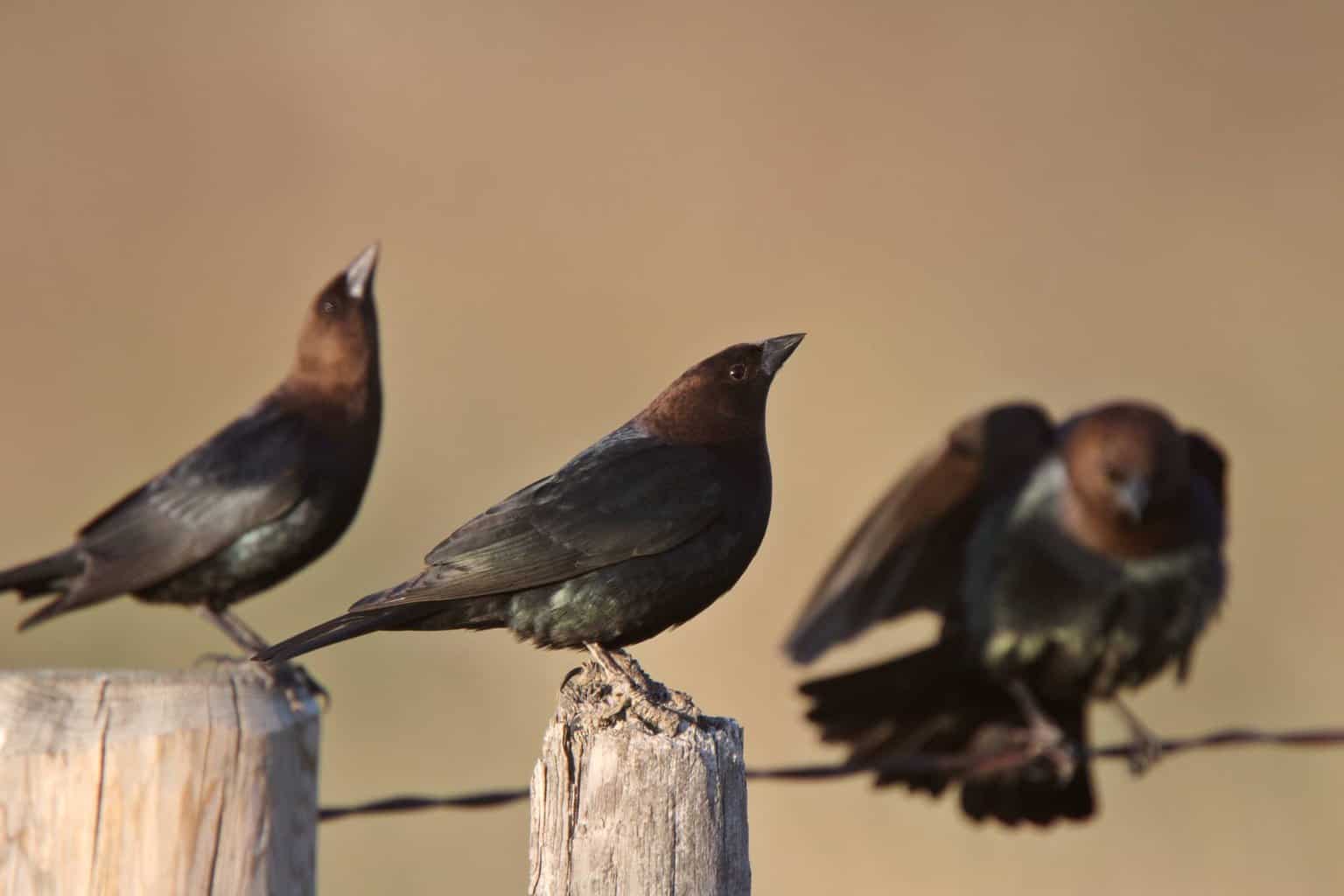
- Scientific Name: Molothrus ater
- Length: 76.3 – 8.7 in (19 – 22 cm)
- Weight: 1.3 – 1.8 oz (42 – 50 g)
- Wingspan: 14.2 in (36 cm)
Brown-Headed Cowbirds are the second most frequently seen blackbird in New Mexico in summer. You are most likely to see them between April and September. However, some do remain residents in the state throughout the rest of the year.
The males are black, with brown heads short tails, and black wings. The female birds are smaller and have streaky brown-gray coloration on their plumage.
One interesting thing about these birds is that they don’t build their nests but lay their eggs in the nests of other birds and have those other birds ‘foster’ their young.
Bullock’s Oriole

- Scientific Name: Icterus bullockii
- Length: 6.7 – 7.5 in (17 – 19 cm)
- Weight: 1.0 – 1.5 oz (29 – 43 g)
- Wingspan: 12.2 in (31 cm)
These birds spend the breeding season in New Mexico. You are most likely to spot them between April and September. However, some do remain here in the state year-round.
The males of this species are a vivid orange color, with white and black wings and black head markings. The female birds and babies are grayish, with yellow coloration on their heads, chests, and tails.
Brewer’s Blackbird

- Scientific Name: Euphagus cyanocephalus
- Length: 7.9 -9.8 in (20-25 cm)
- Weight: 1.8 -3.0 oz (50-86 g)
- Wingspan: 14.6 in (37 cm)
Another year-round resident here in New Mexico, Brewer’s Blackbirds are another blackbird that you might spot in the state. They do not migrate to the West of the US.
Male Brewer’s Blackbirds are glossy black, with purple iridescence on their heads and green sheen on their bodies. The female birds are dowdier and are brown all over.
Yellow-Headed Blackbird
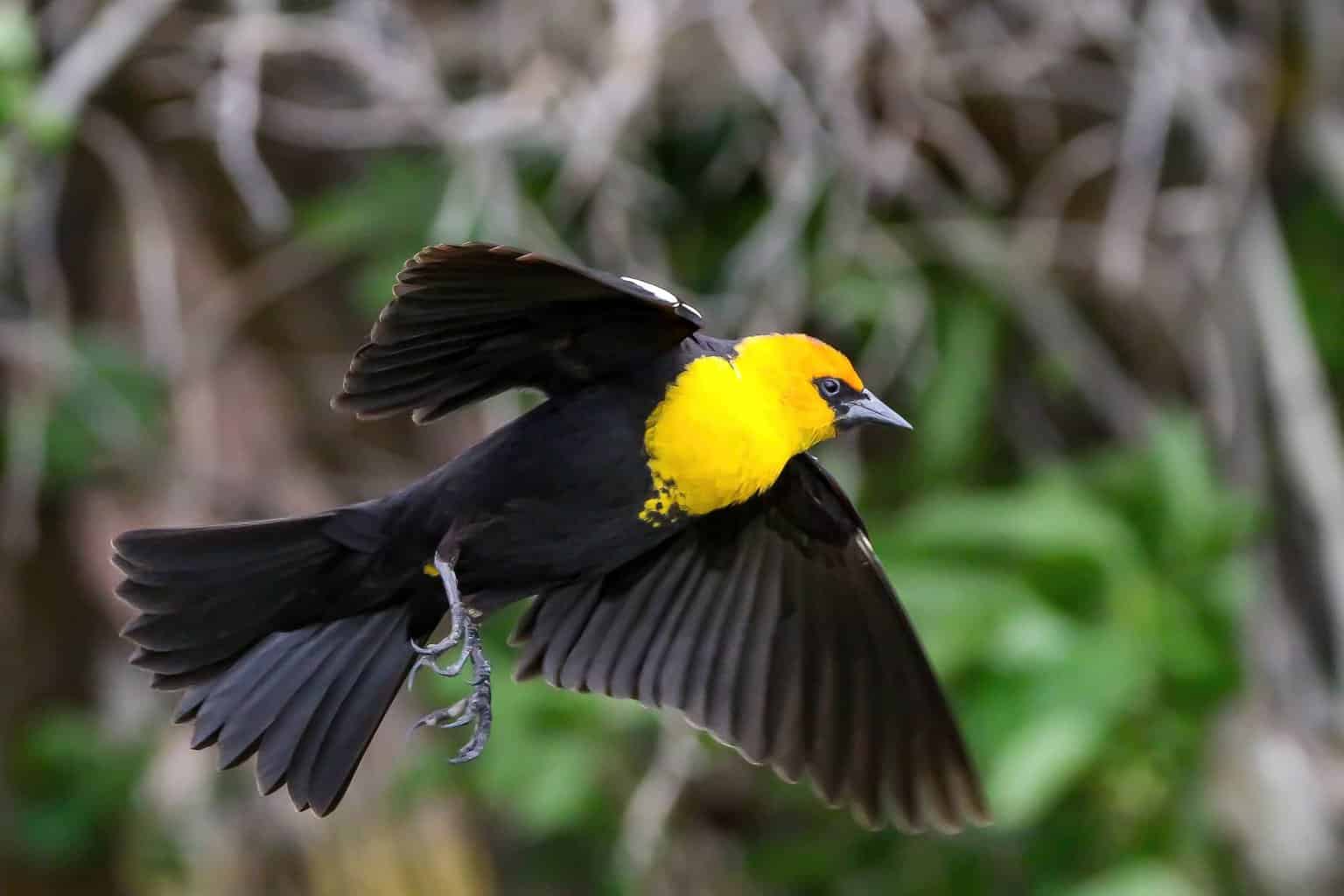
- Scientific Name: Xanthocephalus xanthocephalus
- Length: 8.3 – 10.2 in (21 – 26 cm)
- Weight: 1.6 – 3.5 oz (44 – 100 g)
- Wingspan: 16.5 – 17.3 in (42 – 44 cm)
Yellow-Headed Blackbirds have been spotted in New Mexico throughout the year. However, they are mostly found spending their breeding season in the North of the state. Occasionally, some also spend the winter in the south of the state.
Larger than the Red-Winged Blackbird, the Yellow-Headed Blackbird is named for its yellow head, which is more vivid in the male. Males are glossy black on the rest of their bodies, while the female birds are brown.
Eastern Meadowlark

- Scientific Name: Sturnella magna
- Length: 7.5 – 10.2 in (19 – 26 cm)
- Weight: 3.2 – 5.3 oz (90 – 150 g)
- Wingspan: 13.8 – 15.8 in (35 – 40 cm)
Eastern Meadowlarks are not very common in New Mexico and are considered to be a near-threatened species. However, they can be spotted in the state year-round.
These birds are medium-sized with a musical song. They have bright yellow bellies and brown and black on their backs. Eastern Meadowlarks have distinctive black bands across their chests and are also notable for the range and melodiousness of their musical songs.
Common Grackle

- Scientific Name: Quiscalus quiscula
- Length: 11.0 – 13.4 in (28 – 34 cm)
- Weight: 2.6 – 5.0 oz (74 – 142 g)
- Wingspan: 14.2 – 18.1 in (36 – 46 cm)
Common Grackles are not very common in New Mexico either. They are also considered to be a near-threatened species in the state.
However, they are spotted here during the breeding season, most typically between April and October. Occasionally, individuals may remain year-round.
Taller than other blackbirds, with slightly longer tails, these birds have glossy plumage, but the female birds are slightly less iridescent than the males.
Scott’s Oriole

- Scientific Name: Icterus parisorum
- Length: 9.1 in (23 cm)
- Weight: 1.1 – 1.4 oz (32 – 41 g)
- Wingspan: 12.6 in (32 cm)
These orioles are most commonly seen spending the breeding season in New Mexico. They are typically present from March to October.
Scott’s Orioles are distinctive birds, with bright yellow undersides. The males have black heads and backs, while the female birds have olive-brown backs. The yellow belly is paler in female birds than in males.
Hooded Oriole
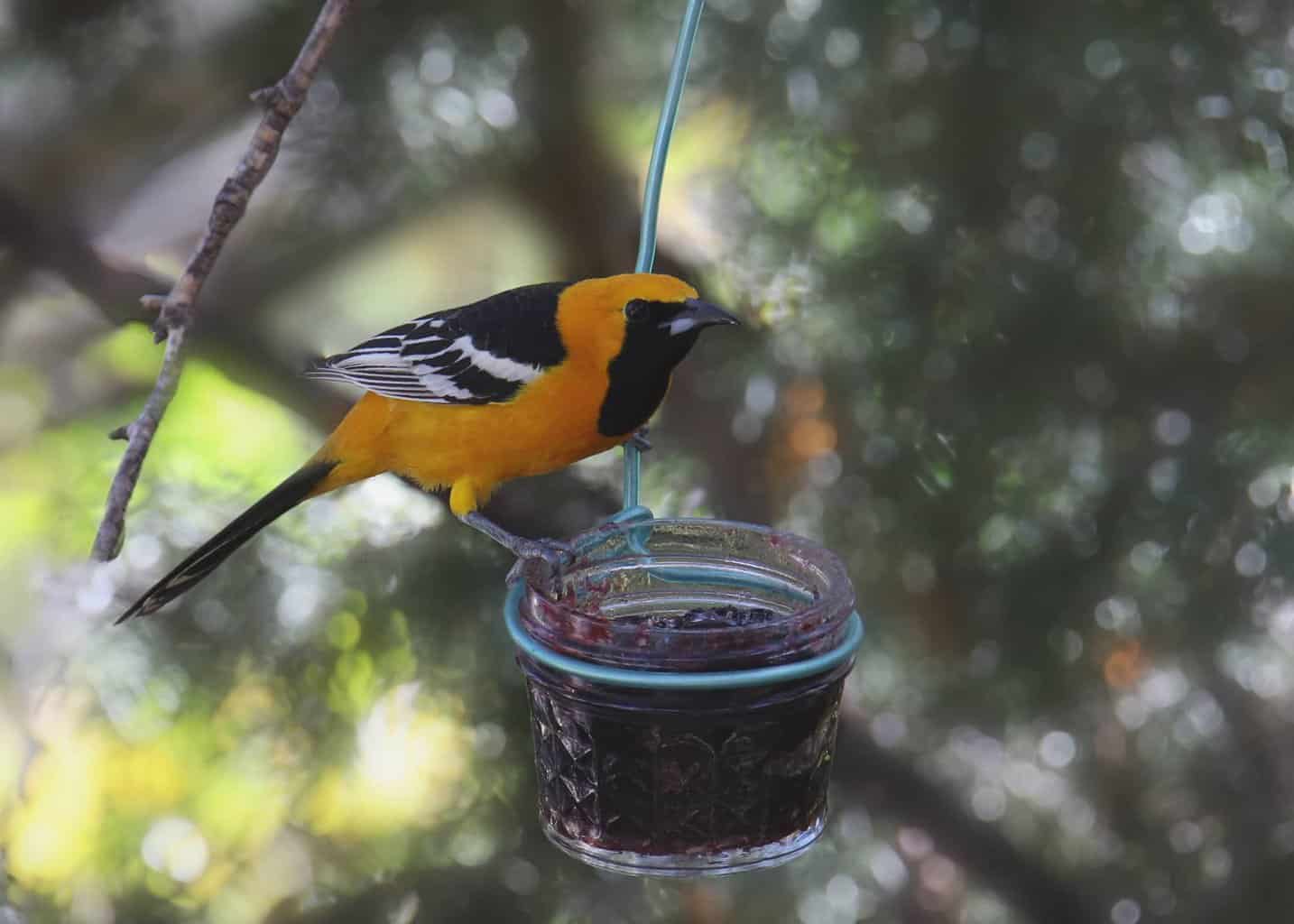
- Scientific Name: Icterus cucullatus
- Length: 7.1 – 7.9 in (18-20 cm)
- Weight: 0.8 oz (24 g)
- Wingspan: 9.1 – 11.0 in (23 – 28 cm)
Hooded orioles can also be spotted in New Mexico during the breeding season. They are typically seen in the southwest of the state.
These birds arrive around mid-March and will remain until around October before they migrate south.
The males are bright yellow or orange, with black backs, throats, and face markings. The female birds and babies are more yellow, with grayish coloration on their wings. They do not have face markings like the males.
Bronzed Cowbird

- Scientific Name: Molothrus aeneus
- Length: 7.9 in (20 cm)
- Weight: 2.3 – 2.6 oz (64.9 – 73.9 g)
- Wingspan: 13.0 in (33 cm)
Though not often spotted in New Mexico, these birds also spend the breeding season here and some may occasionally stay here year-round.
Bronzed cowbirds are stocky blackbirds. The males are black, with a glossy dark blue sheen to their wings. They have bright red eyes. The female birds are brown with red eyes. Juveniles, however, have black eyes before they mature.
Orchard Oriole

- Scientific Name: Icterus spurius
- Length: 5.9 – 7.1 in (15 – 18 cm)
- Weight: 0.6 – 1.0 oz (16 – 28 g)
- Wingspan: 9.8 in (25 cm)
Though rarely spotted in New Mexico, orchard orioles are recognized as regularly occurring in the state. They can be seen here between April and early October.
Male Orchard Orioles have bold coloring—they are black on top and vivid red underneath. The female birds look very different, with a greenish-yellow hue and white wing bars.
Concluding Thoughts:
Though these birds are the main ones encountered in New Mexico, there have been rare sightings of other blackbirds, including Rusty blackbirds, Bobolinks, Baltimore orioles, and streak-backed orioles. These are considered accidental or vagrant species. The birds on this list are those most commonly seen.

